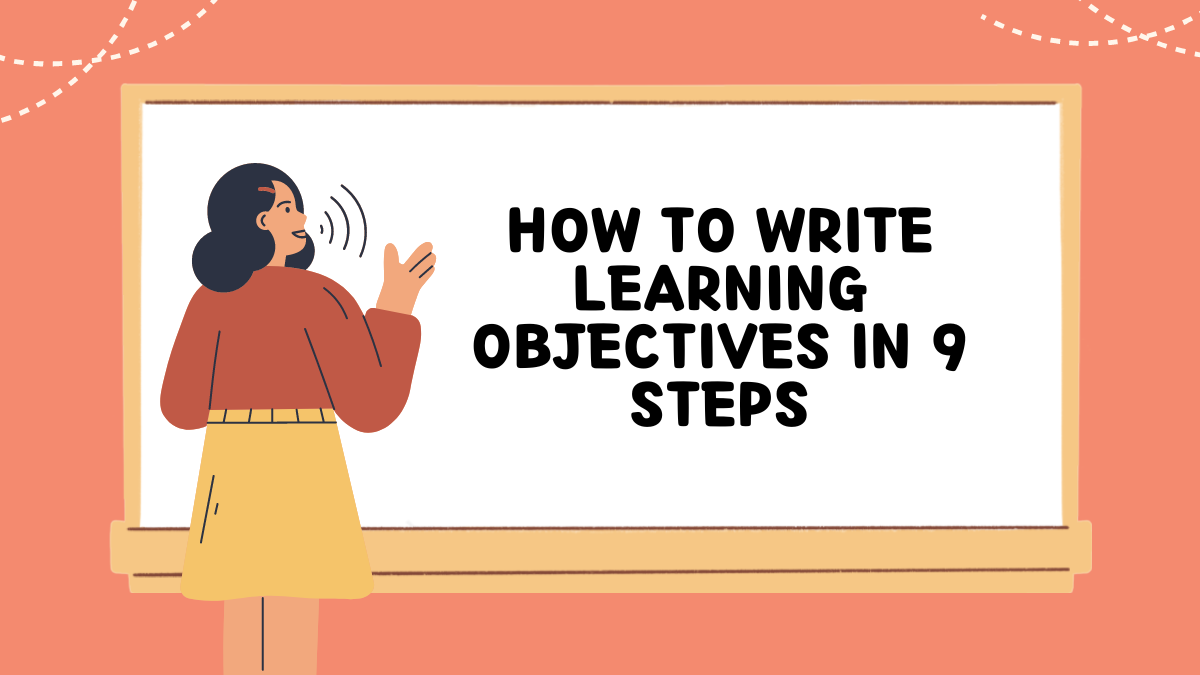
How to Write Learning objectives play a crucial role in educational settings, providing a roadmap for both educators and learners to achieve desired outcomes. Whether you’re designing a course, developing a training program, or planning a lesson, clear and well-defined learning objectives are essential for success. In this comprehensive guide, we’ll explore the intricacies of writing effective learning objectives, from understanding their components to practical tips for implementation.
Table of Contents
Introduction
Learning objectives(how to write learning objectives) serve as guiding principles that define what learners should be able to accomplish after completing a learning activity. They provide clarity and direction, helping to focus instructional efforts and measure the success of the learning experience. Without clear objectives, learners may struggle to understand expectations and educators may find it challenging to assess progress effectively.
1. Components of Effective Learning Objectives
Effective learning objectives typically possess five key components(how to write learning objectives):
Specificity
Learning objectives should be clear, precise, and unambiguous, leaving no room for interpretation. They should clearly state what learners are expected to know or be able to do.
Measurability
Objectives should be measurable, allowing educators to assess whether learners have achieved the desired outcomes. Measurable objectives often involve observable behaviors or tangible outcomes.
Achievability
Objectives should be realistic and attainable within the given timeframe and resources. Setting unattainable objectives can lead to frustration and disengagement among learners.
Relevance
Objectives should be relevant to the learning context and aligned with the overall goals of the instructional program. They should address the needs and interests of the learners, ensuring relevance and motivation.
Time-bound
Objectives should be time-bound, specifying a timeframe within which they are expected to be achieved. This helps to create a sense of urgency and accountability among learners.
2. Steps to Writing Effective Learning Objectives
Writing effective learning objectives involves a systematic approach(how to write learning objectives):
Identify the Learning Outcome
Begin by clearly defining the desired learning outcome or competency. What do you want learners to know, understand, or be able to do by the end of the learning activity?
Use Action Verbs
Use action verbs to describe observable behaviors or actions that demonstrate mastery of the learning objective. Common action verbs include “analyze,” “synthesize,” “evaluate,” and “apply.”
Specify Conditions
Specify any conditions or constraints under which the learning will take place. This could include specific resources, tools, or environments required to achieve the objective.
Determine the Criteria for Success
Define the criteria for success or proficiency. How will you know when learners have successfully achieved the objective? This could involve performance criteria, assessment rubrics, or other measures of proficiency.
3. Examples of Well-Written Learning Objectives
Well-written learning objectives vary depending on the context and intended outcomes(how to write learning objectives):
Academic Context
- Objective: Students will be able to analyze and interpret primary source documents from the Civil War era to draw conclusions about the social and political impact of the conflict.
Professional Development
- Objective: Participants will demonstrate effective communication skills by delivering a persuasive presentation to a simulated client audience.
Personal Growth
- Objective: Learners will develop mindfulness techniques and apply them to manage stress and enhance overall well-being.
4. Common Mistakes to Avoid
When writing learning objectives, it’s important to avoid common pitfalls(how to write learning objectives):
Vagueness
Avoid vague or ambiguous language that can lead to confusion or misinterpretation. Be clear and specific about what learners are expected to achieve.
Complexity
Keep objectives concise and straightforward. Avoid overly complex language or concepts that may overwhelm learners.
Lack of Alignment
Ensure that objectives are aligned with the overall goals and objectives of the instructional program. Lack of alignment can lead to disjointed learning experiences.
5. Benefits of Clear Learning Objectives
Clear learning objectives offer numerous benefits(how to write learning objectives):
Enhanced Focus
Clear objectives help learners focus their attention and efforts on the most important content and skills.
Improved Assessment
Objectives provide a framework for assessing learner progress and proficiency, enabling educators to provide targeted feedback and support.
Better Learning Outcomes
Well-defined objectives contribute to improved learning outcomes by providing a clear roadmap for success.
6. Tips for How to Write Learning Objectives
Implementing learning objectives effectively requires careful planning and communication:
Communicate Objectives Clearly
Clearly communicate learning objectives to learners at the beginning of the instructional activity. This sets expectations and helps learners understand the purpose of the learning experience.
Align Objectives with Assessments
Ensure that assessments align with the stated learning objectives. Assessments should measure the desired outcomes and provide opportunities for learners to demonstrate their proficiency.
Provide Feedback on Objectives
Provide feedback on learner progress towards achieving the objectives. This feedback helps learners track their progress and identify areas for improvement(how to write learning objectives).
Visual Learners
For visual learners, consider incorporating charts, graphs, diagrams, and other visual aids to reinforce key concepts. Learning objectives can include activities that involve visual processing, such as creating mind maps or watching educational videos.
Auditory Learners
Auditory learners benefit from hearing information presented orally. Learning objectives may involve activities such as listening to lectures, participating in group discussions, or recording and listening to audio summaries of content.
Kinesthetic Learners
Kinesthetic learners learn best through hands-on experiences and physical activities. Learning objectives for kinesthetic learners may include activities such as experiments, role-playing exercises, or interactive simulations.
7. Measuring the Effectiveness of Learning Objectives
Assessing the effectiveness of learning objectives is essential for continuous improvement. Several methods can be used to measure the achievement of learning outcomes(how to write learning objectives):
Pre-assessment and Post-assessment
Comparing learners’ performance before and after completing a learning activity can provide insights into the effectiveness of the objectives. Pre-assessments establish a baseline, while post-assessments measure the extent to which learning objectives have been achieved.
Feedback from Learners
Gathering feedback from learners about their learning experiences can help identify areas for improvement. Surveys, focus groups, or individual interviews can provide valuable insights into the effectiveness of learning objectives and instructional methods(how to write learning objectives).
Achievement of Desired Outcomes
Ultimately, the achievement of desired learning outcomes is the most significant measure of the effectiveness of learning objectives. Assess whether learners have acquired the knowledge, skills, and competencies outlined in the objectives.
8. The Role of Learning Objectives in Curriculum Design
Learning objectives play a central role in curriculum design, guiding the development of instructional materials and activities. They help ensure alignment between educational goals, instructional content, and assessment strategies(how to write learning objectives):
Integration into Lesson Plans
Learning objectives should be integrated seamlessly into lesson plans, guiding the selection of instructional strategies, resources, and assessments.
Alignment with Educational Standards
Learning objectives should align with relevant educational standards and objectives, ensuring that instruction is consistent with established guidelines and benchmarks.
Continuous Improvement
Regular review and revision of learning objectives are essential for maintaining relevance and effectiveness. Curriculum designers should continuously monitor learner progress and feedback to inform updates and revisions to objectives(How to write learning objectives).
Challenges in Writing Learning Objectives
While learning objectives are invaluable tools for guiding instruction, they also present challenges(how to write learning objectives):
Balancing Specificity and Flexibility
Finding the right balance between specific, measurable objectives and flexibility can be challenging. Objectives should be clear and specific, yet allow for adaptation to accommodate diverse learners and instructional contexts.
Ensuring Relevance to Diverse Learners
Writing objectives that are relevant to a diverse group of learners with varying backgrounds, experiences, and learning styles requires careful consideration and planning.
Addressing Changing Learning Needs
As educational trends and priorities evolve, learning objectives must adapt to address changing learning needs and priorities. Curriculum designers must stay abreast of emerging research and best practices in education.
9. Future Trends in Learning Objective Development
The future of learning objective development is marked by technological advancements and a focus on personalized learning experiences(how to write learning objectives):
Adaptive Learning Technologies
Advancements in adaptive learning technologies leverage AI and data analytics to provide personalized learning experiences tailored to individual learner needs and preferences.
Personalized Learning Experiences
The shift towards personalized learning experiences acknowledges that learners have unique strengths, interests, and goals. Learning objectives will increasingly reflect this emphasis on customization and personalization.
Incorporation of AI in Objective Setting
AI-powered tools and algorithms can assist educators in setting and refining learning objectives based on learner data and feedback. These tools offer opportunities for more dynamic and responsive instructional design.
Best Practices for Reviewing and Updating Learning Objectives
To ensure that learning objectives remain relevant and effective, it’s essential to follow best practices for reviewing and updating them(how to write learning objectives):
Regular Assessment of Relevance
Regularly assess the relevance of learning objectives in light of changing educational priorities, learner needs, and industry trends.
Feedback from Stakeholders
Seek feedback from stakeholders, including learners, educators, administrators, and industry professionals, to inform updates and revisions to learning objectives.
Incorporation of New Research and Methodologies
Stay abreast of new research, methodologies, and best practices in education to inform the development of learning objectives(how to write learning objectives). Incorporate evidence-based strategies for enhancing learning and engagement.
Visit Website :- guest post buy
Also Visit :- Telegram
Conclusion
In conclusion of how to write learning objectives, writing effective learning objectives is essential for guiding instructional design, enhancing learner engagement, and promoting successful learning outcomes. By following best practices for writing, implementing, and evaluating learning objectives, educators can create meaningful and impactful learning experiences for learners of all ages and backgrounds.
What are learning objectives?
Ans. Learning objectives are statements that specify what learners should know, understand, or be able to do as a result of a learning experience. They provide a clear focus for instruction and serve as criteria for assessing learner progress and proficiency.
Why are learning objectives important?
Ans. Learning objectives are important because they provide clarity and direction, guiding instructional design and assessment practices. They help learners understand expectations, focus their efforts, and track their progress towards achieving desired outcomes.
How do you write measurable learning objectives?
Ans.
To write measurable learning objectives, use action verbs that describe observable behaviors or actions, specify conditions under which learning will take place, and define criteria for success or proficiency. Ensure that objectives are clear, specific, and achievable within the given timeframe and resources.
Can learning objectives be revised during a course?
Ans.
Yes, learning objectives can be revised during a course based on ongoing assessment of learner progress and feedback. Revisions may be necessary to address changing learner needs, instructional challenges, or emerging priorities.
How do learning objectives differ from goals?
Ans.
While learning objectives specify what learners should know, understand, or be able to do, goals are broader statements of intention or purpose. Goals provide overarching direction and context for learning objectives, guiding instructional planning and assessment practices.





